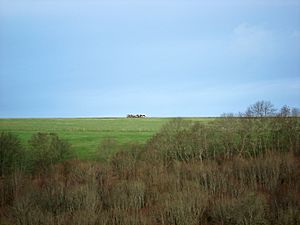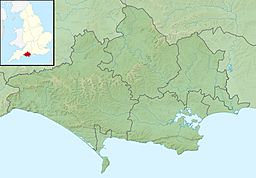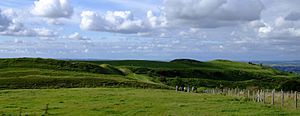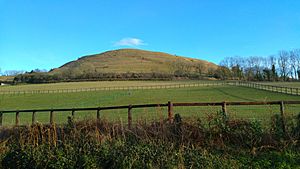Hambledon Hill facts for kids
Quick facts for kids Hambledon Hill |
|
|---|---|

Child Okeford and Hambledon Hill seen from west
|
|
| Highest point | |
| Elevation | 192 m (630 ft) |
| Prominence | 140 |
| Parent peak | Win Green |
| Listing | HuMP |
| Geography | |
| Location | North Dorset, Dorset, England, UK |
| Parent range | Cranborne Chase |
| OS grid | ST845126 |
| Topo map | OS Landranger 194 |
| Geology | |
| Age of rock | Cretaceous |
| Climbing | |
| Easiest route | Walk |
Hambledon Hill is a very old hill fort in Dorset, England. It is located in the Blackmore Vale, about five miles northwest of Blandford Forum. The hill is made of chalk and is part of the Cranborne Chase area. The River Stour separates it from the Dorset Downs. Today, the National Trust owns this important historical site.
Contents
History of Hambledon Hill

Ancient Times: Neolithic and Iron Age
Early Settlements: Neolithic Period
People first lived on Hambledon Hill a very long time ago, during the Neolithic period (the New Stone Age). They built two special causewayed enclosures at the top of the hill. These were large areas surrounded by banks and ditches. One enclosure was smaller than the other, and they were connected by another bank and ditch.
There were also two long burial mounds, called long barrows, inside this area. One of these mounds was about 68 meters (223 feet) long. Another hidden enclosure is now known to be under later earthworks. All together, the area where people lived and worked covered more than one square kilometer.
Archaeologists dug up the site in the 1970s and 1980s. They found many items from the Neolithic period. Studies showed that the area was still covered in forests when people first lived there. The forests were cleared later, during the Bronze Age. Scientists also found charcoal from wooden fences that were part of the Neolithic earthworks.
Life and Violence in the Neolithic Period
Using radiocarbon dating, scientists found that the site was active around 2850 BC. They found the skeleton of a young man who had been killed by an arrow. This suggests that there was violence at the site, possibly when the wooden defenses were burned.
Archaeologists also found a single grape pip and a leaf fragment. This shows that people might have grown vines there. The people living on Hambledon Hill also traded with other groups further to the southwest.
The ditches of the enclosures contained many pieces of pottery. They also had red deer antler picks, which people used to dig the ditches. Human skulls were found at the very bottom of one ditch. These might have been placed there as offerings or to honor ancestors.
Studies of animal bones suggest that most meat was eaten in late summer and early autumn. This could mean that the site was used only at certain times of the year. Different items were found in different parts of the site. This suggests that Hambledon Hill was divided into different areas for various activities. Some experts believe the large enclosure was used for ceremonies to honor the dead. The smaller enclosure might have been used for feasting and social gatherings.
Iron Age Fort: A Stronghold
Not much is left of the Neolithic activity today. However, Hambledon Hill is a great example of an Iron Age hill fort. At first, it had only one set of banks and ditches. Later, more banks and ditches were added, making the fort much bigger. It grew to cover about 125,000 square meters (31 acres).
The fort had three entrances. The southwestern entrance had a long, curved defense called a hornwork, about 100 meters (328 feet) long. You can still see flat areas on the hillside where huts once stood. The site seems to have been left empty around 300 BC. People might have moved to the nearby Hod Hill at that time.
Hambledon Hill is the first in a line of important Iron Age earthworks. This chain includes Hod Hill, Spetisbury Rings, Buzbury Rings, Badbury Rings, and Dudsbury Camp. The Iron Age port at Hengistbury Head is the last major site in this group.
The Clubmen's Battle
During the English Civil War (1642-1651), there was a group called the Clubmen. They were not on the side of the King or Parliament. Instead, they wanted to protect their land from soldiers who would take food and supplies. They armed themselves with clubs and farm tools.
In August 1645, between 2,000 and 4,000 Clubmen gathered on Hambledon Hill. At this time, many of Oliver Cromwell's troops were in the area. Cromwell ordered his well-trained New Model Army to break up the Clubmen's gathering. On August 4, Cromwell's soldiers easily drove them away. The leaders were arrested, but Cromwell sent most of the Clubmen home, calling them 'poor silly creatures'.
Protecting Nature: Hambledon Hill Today
Amazing Plants and Animals
Today, Hambledon Hill is a National Nature Reserve (NNR). This means it is a special place protected for its wildlife. Many common plants grow here, such as milkwort, salad burnet, horseshoe vetch, squinancywort, pyramidal orchid, and wild thyme.
Rarer plants also live on the hill. These include bastard toadflax, meadow saxifrage, early gentian, and dwarf sedge. Many beautiful butterflies can be seen here too. Some examples are the dingy skipper, grizzled skipper, chalkhill blue, and Adonis blue.
A Protected Place
In August 2014, the National Trust bought Hambledon Hill fort for £450,000. The money came from a grant and a special gift left to help the Dorset countryside. The hill fort is a Scheduled Monument. This means it is a nationally important archaeological site that is protected by law. The nearby Neolithic causewayed camp is also a Scheduled Monument.
Images for kids





